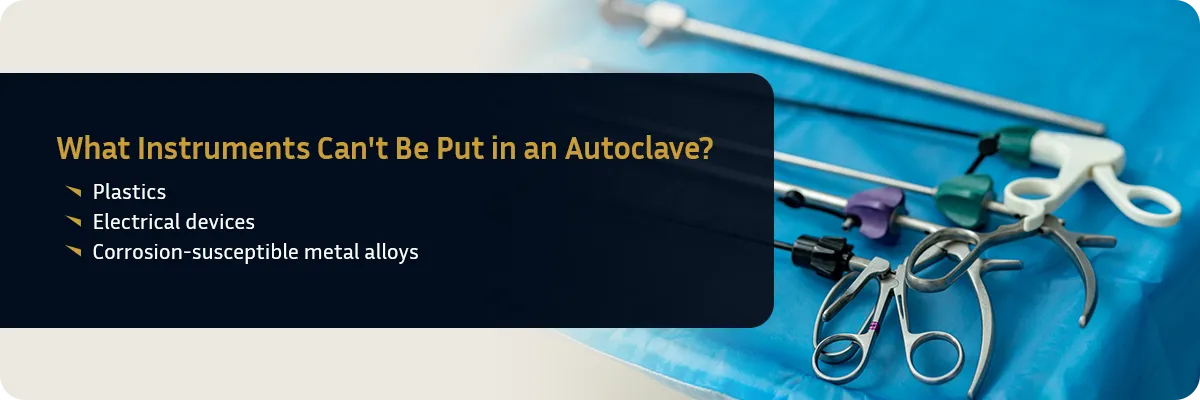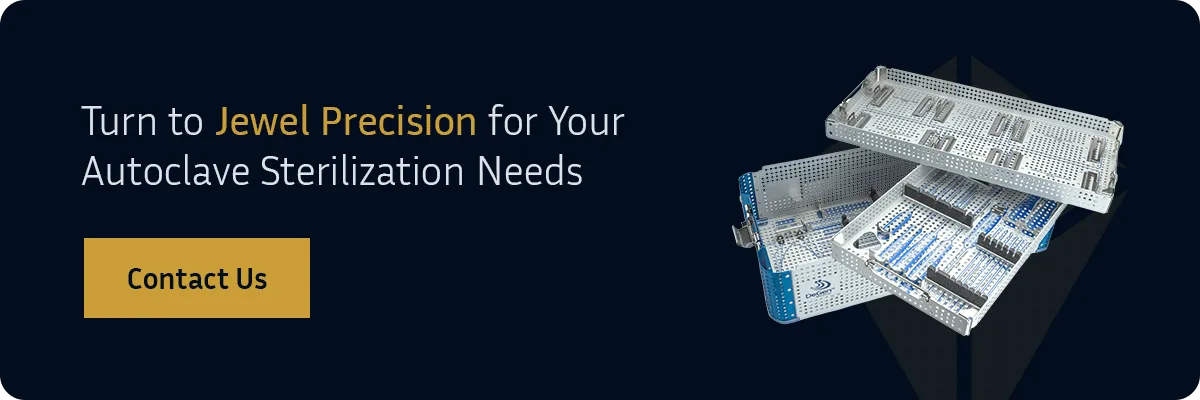
Table Of Contents:
- How Medical Facilities Use Autoclave Systems
- What Instruments Can Be Put in an Autoclave?
- What Instruments Can’t Be Put in an Autoclave?
- Frequently Asked Questions About Autoclaves
- Turn to Jewel Precision for Your Autoclave Sterilization Needs
Hospitals rely on autoclave systems to effectively sterilize their instruments to protect their patient’s health and well-being. Proper sterilization is essential to ensure that medical tools are clean and safe to use.
Understanding what materials can go into the system’s chamber is crucial for maintaining the safety of those working with the autoclave. Putting the wrong instruments in the machine can be detrimental to staff members, tools and the equipment itself.
Learn more about what instruments can and cannot go into an autoclave and additional considerations for using these systems.
How Medical Facilities Use Autoclave Systems
Hospitals and medical laboratories use autoclaves to sterilize important instruments and materials. These systems utilize pressurized steam to kill:
- Harmful bacteria
- Viruses
- Fungi
- Spores
In addition to effectively killing microorganisms, steam is safer than other cleaning chemicals and agents because it is non-toxic.
How Does an Autoclave Sterilize Instruments?
An autoclave cleans materials by utilizing the four parameters of steam sterilization:
- Steam
- Pressure
- Temperature
- Time
These systems work by directing steam at instruments at a set temperature and pressure for a set amount of time. Medical facilities use this cleaning process because it is highly effective and takes only a short time to complete.
Once they’re sterile, the tools and materials are safe for use. Medical staff can continue operations knowing their instruments are not going to harm their patients.
What Instruments Can Be Put in an Autoclave?
Not all medical instruments can safely go inside an autoclave. Those working with these systems must familiarize themselves with what materials can safely withstand high temperatures and pressures. Before placing anything inside an autoclave, it is essential to determine whether or not the material can safely endure the sterilization process to avoid injuries and harm.
You can safely sterilize these items in an autoclave:
- Surgical instruments
- Glassware
- Autoclavable plastic ware
- Centrifuge tubes
- Pipette tips
- Chemical solutions
- Water (commonly used for animal consumption)
- Animal food and bedding
- Biomedical waste
- Hospital linens
When it comes to specific surgical instruments, the following are safe to put in an autoclave:
- Scalpels
- Forceps
- Hemostats
- Scissors
- Screws
- Implants
- Plates
- Syringes
- Implantable medical devices
Hospitals can organize these tools in the chamber with specialized instrument cases that are safe for autoclaving and provide an easy storage solution.
Medical facilities can also utilize these systems to deep clean surgical linens and drapes. Personal protective equipment can also withstand the sterilization process in an autoclave, making it safe for:
- Heat-resistant gloves
- Lab coats
- Safety glasses
The following are additional materials that can be autoclaved:
- Latex
- Vinyl
- Paper
- Metals
- Culture plates and flasks
- Biological research instruments
What Instruments Can’t Be Put in an Autoclave?

Do not autoclave flammable, combustible, reactive, corrosive, toxic, or radioactive materials. Also, not all plastics can be autoclaved, so check that they are compatible with the autoclave.
- Plastics
- Electrical devices
- Corrosion-susceptible metal alloys
- Flammable materials
- Acids
- Explosive materials
- Chlorine and chlorides
- Bleach
- Non-stainless steel
- Saltwater
- Sulfates
- Radioactive materials
- Reactive materials
- Corrosive materials
- Toxic material
- Liquids in sealed containers
- Oxidizers
- Solvents
Hospitals and medical facilities must pay close attention to what goes into their autoclave systems.
Frequently Asked Questions About Autoclaves
Explore the following commonly asked questions about autoclave systems and their uses:
What Happens If You Autoclave the Wrong Instrument?
Putting the wrong instruments and materials into an autoclave can be very dangerous for those nearby. By failing to follow necessary safety protocols, you risk the following:
- Burn hazards: Putting the wrong instrument into an autoclave system can lead to fires and burning. The machine reaches extremely high temperatures that can result in severe burns for those loading and unloading materials without proper precautions.
- Explosion hazards: In cases where the autoclave door malfunctions or a user loads the system improperly, the mixture of heat and pressure escaping from the chamber can result in a serious and potentially harmful explosion. Likewise, placing oxidizers into the chamber can lead to an eruption.
- Melting and shattering: Loading the autoclave with items that can’t resist heat can cause unwanted melting or shattering during the sterilization cycle. In addition to harming the materials, this can cause issues inside the chamber.
- Damage to the machine: Whenever you insert the wrong instrument into an autoclave, you risk damaging the system itself.
What Protective Gear Do You Need for Autoclaving?
Anyone who is working with an autoclave must wear personal protective equipment, including:
- Lab coat
- Eye protection
- Heat-resistant gloves
- Closed-toe shoes
Your gear is essential for protecting your body from both the materials you are handling and the potential dangers of the autoclave system.
What Are Signs an Autoclave Is Not Operating Properly?
Autoclaves do not always operate correctly and medical facilities must pay close attention to ensure their instruments are properly sterilized. Some signs that the machine is not working properly include:
- The load is still wet after drying time: If materials, especially linens, aren’t adequately spaced out in the chamber, they can retain water.
- Discoloration spots and marks on your tools: Poor steam quality can result in mineral deposits on your tools. Spots can also appear due to buildup if users do not thoroughly wash off detergents.
- The system will not reach the set temperature: Failing to reach sterilization temperature can indicate that there may be a clog in the chamber’s drain, and the system needs maintenance.
Turn to Jewel Precision for Your Autoclave Sterilization Needs

Jewel Precision has dependable, custom container systems for autoclave protection for your hospital or medical center’s instruments and materials. Our cases’ superior quality means they will protect your tools for many sterilization cycles.
In addition to our durable and innovative cases, we also offer competitive pricing. We have a friendly and highly engaged customer service team to help you find the cases and trays you need. Our short lead times also make it possible for you to get your supplies when you need them.
Interested in learning more about our high-quality sterilization container systems? Contact Jewel Precision today!